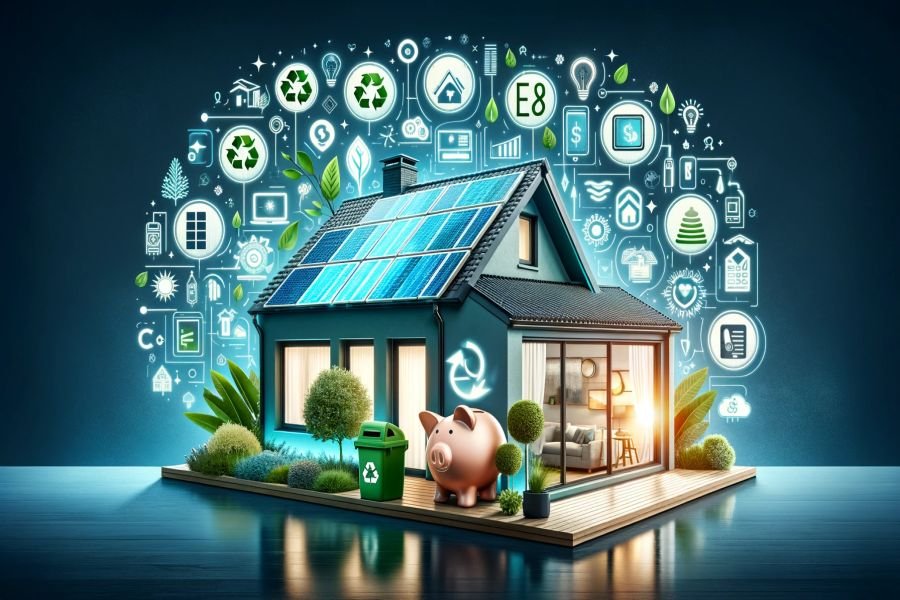The world is increasingly focused on combating climate change and reducing our carbon footprint. As individuals, one impactful way we can contribute is by making our homes more energy efficient. Switching to renewable energy sources, weatherizing, and upgrading to high-efficiency appliances are a few ways to lower energy use and emissions.
Luckily, the U.S. government provides incentives for homeowners to make these environmentally-friendly home improvements. For tax years 2023 and beyond, there are two valuable tax credits available: the Energy Efficient Home Improvement Credit (EEHIC) and the Residential Clean Energy Credit (RCE).
These credits allow homeowners to reap significant tax savings for installing eligible energy-efficient products and systems. Even better, they motivate more individuals to upgrade their homes in eco-friendly ways.
Read on to learn all about these green home tax credits and how to take advantage of them.
An Introduction to the Tax Credits
The EEHIC and RCE provide substantial incentives for U.S. homeowners improving the energy efficiency of their primary residence. These credits apply to both existing homes and newly constructed homes.
The EEHIC covers a wide range of upgrades, including insulation, doors, windows, roofing, and heating and cooling system upgrades. The RCE focuses more narrowly on specific renewable energy systems for the home.
These credits allow homeowners to claim a tax credit equal to 30% of the cost (up to preset limits) for qualified improvements in the same tax year the upgrades were made. The credits offer homeowners up to thousands of dollars in tax savings while also promoting energy conservation nationwide.
The Energy Efficient Home Improvement Credit
The Energy Efficient Home Improvement Credit was introduced under the Inflation Reduction Act signed into law in August 2022. This credit is the broader of the two, encompassing many different efficiency upgrades for residential buildings.
Overview of the EEHIC
The EEHIC provides a nonrefundable tax credit for 30% of the cost of qualified energy-efficient improvements made to a homeowner’s principal residence. This credit covers a wide scope of upgrades, including:
- Doors
- Windows
- Insulation
- Certain roofing
- Heating, ventilation, and air conditioning (HVAC) systems
- Water heaters
- Biomass stoves
- And more
Nearly any home improvement that raises your home’s efficiency qualifies for this credit. It can be applied along with utility or state/local rebates as well.
There are no limits on the number of projects or the total amount that can be claimed, as long as the products meet eligibility standards. The credit is calculated based on the total expenditures for improvements installed that tax year.
This provides homeowners with an ongoing incentive to continuously enhance their home’s energy performance over time.
Eligible EEHIC Home Improvements
The EEHIC encompasses a wide range of energy-saving home upgrades:
- Windows – Energy-efficient windows with proper ENERGY STAR certification qualify. This includes both windows and skylights.
- Doors – Insulated exterior doors and storm doors boost efficiency.
- Insulation – Additional insulation improves thermal performance.
- Roofing – ENERGY STAR-certified metal and asphalt roofs increase reflectivity.
- HVAC systems – High-efficiency heat pumps, furnaces, boilers, and central air conditioners are covered.
- Water heaters – ENERGY STAR-certified heat pumps and solar water heaters qualify.
- Biomass stoves – High-efficiency wood-burning stoves are eligible.
- Battery storage – Home battery systems paired with solar panels qualify.
- Electrical panel upgrades – Upgrades needed to install eligible improvements qualify.
- And more – Other efficiency products like duct sealing, air sealing, and energy-efficient exterior siding may qualify if they meet certain technical requirements.
Always verify that products meet the required efficiency criteria before purchasing. The highest efficiency equipment will provide the most energy savings over time.
Utilizing the EEHIC
To utilize the EEHIC, homeowners need to:
- Make qualifying improvements in the tax year they wish to claim the credit.
- Determine the total cost of these upgrades. Keep all installation invoices and receipts.
- Claim the credit equal to 30% of the total cost when filing their taxes for that year.
- Report the credit amount on IRS Form 5695.
There is no limit to the number of upgrades that can be claimed each year. Homeowners should claim all eligible improvements made that tax year to maximize potential savings.
Upgrades can be made to an existing home or a newly constructed home. The home must be the homeowner’s principal residence to qualify. Rental properties and second homes do not qualify.
The Residential Clean Energy Credit

Alongside the EEHIC, homeowners can also utilize the Residential Clean Energy Credit. While more limited in scope, this credit focuses on renewable energy systems for the home.
Overview of the RCE Credit
The Residential Clean Energy Credit provides incentives for homeowners to install specific renewable energy equipment in their homes. This includes:
- Electric and natural gas heat pump heating/cooling systems
- Biomass boilers and stoves
- Solar water heating systems
- Small wind turbines
For qualifying equipment, homeowners can claim a credit equal to 30% of the cost. Total credits are capped at certain amounts, depending on the type of project.
The RCE credit amounts to substantial savings, encouraging homeowners to utilize clean energy alternatives. This advances renewable energy nationwide while reducing reliance on fossil fuels.
Eligible Renewable Energy Projects
Several categories of renewable systems are covered by the RCE credit:
- Heat Pumps – Electric and natural gas heat pump HVAC systems are eligible. Credit up to $2,000 per heat pump ($6,000 max per year).
- Biomass Equipment – High-efficiency wood pellet stoves, boilers, and furnaces qualify. Credit up to $2,500 per stove or boiler ($600 max per year for stoves).
- Solar Water Heaters – Systems heating water through solar thermal energy qualify. Credit up to $2,000 per year.
- Small Wind Turbines – Turbines with a capacity ≤ 100 kW qualify. Credit up to $500 per kW of capacity per year.
- Fuel Cells – Stationary fuel cell systems in the home qualify. Credit up to $500 per 0.5 kW of capacity.
Always verify equipment meets the required certification standards to qualify for the credit.
Utilizing the RCE Credit
To receive the RCE credit, homeowners must:
- Install eligible equipment in the tax year they want to claim the credit.
- Determine the cost of purchase and installation. Keep all invoices and receipts.
- Calculate the correct credit value based on 30% of the cost or the per unit caps.
- Claim the credit amount on IRS Form 5695 when filing taxes that year.
The RCE credit can be combined with state/local/utility incentives. The home must be the homeowner’s primary residence to qualify.
Comparing the Two Credits
The table below summarizes some key differences between the EEHIC and the RCE home tax credits:
| Energy Efficient Home Improvement Credit | Residential Clean Energy Credit | |
|---|---|---|
| Eligible Projects | A broad range of efficiency upgrades like insulation, windows, HVAC, etc. | Specific renewable energy equipment like solar water heating and heat pumps |
| Credit Amount | 30% of the cost for all qualifying improvements | 30% of the cost up to per unit caps |
| Spending Caps | No caps | Individual caps per type of equipment |
| Expiration | None currently set | Expires December 31, 2034 |
The credits are complementary, allowing homeowners to do multiple upgrades and leverage both incentives. The EEHIC covers a wider range of improvements with no spending limits. The RCE focuses more narrowly but has expiration dates homeowners should note.
Conclusion
The Energy Efficient Home Improvement Tax Credit and the Residential Clean Energy Credit provide substantial incentives for U.S. homeowners to upgrade their homes for energy efficiency and renewable energy.
If you’ve been considering new windows, insulation, solar panels, or other green upgrades, now is the perfect time to invest in your home’s performance.
These tax credits mean you can recoup 30% of the project costs immediately in tax savings. This tempers the upfront costs while also contributing to energy conservation and sustainability.
Be sure to research which improvements qualify and verify they meet efficiency specifications. Consult with reputable contractors to assist with installations as well. With sound planning, you can leverage these credits for significant tax relief while also benefitting the environment.
Make your home part of the climate solution and lower your energy costs for years to come. Contact a tax professional or the IRS.
FAQs
What are the key benefits of these home energy tax credits?
The main benefits are substantial tax savings and the promotion of energy efficiency and renewable energy nationwide. Homeowners can get back 30% of the cost of upgrades via tax credits.
What is an efficient or renewable upgrade my home needs?
Every home is different, but common upgrades are insulation, air sealing, ENERGY STAR windows and appliances, LED lighting, heat pumps, and solar panels. Consult a home energy audit to identify your home’s needs.
How do I claim these credits when I file my taxes?
Use IRS Form 5695 to calculate your credit amount based on the costs of improvements. Submit this form along with your standard 1040 tax return. Keep detailed records of all eligible projects and costs.
Can I claim credits for a newly built home?
Yes, the same credits apply to new homes. Make sure to install qualifying energy-efficient or renewable products during construction and keep receipts.
Can I combine these credits with other incentives?
Absolutely. You can “stack” these credits on top of any federal, state, local, or utility rebates available. This maximizes your savings from green upgrades.
What if I split these upgrades across multiple years?
You can claim credits only for improvements made in the specific tax year you are filing for. However, you can extend projects across multiple years to take advantage of the credits each year.
When do these credits expire?
The EEHIC currently has no planned expiration date. The RCE credit expires after December 31, 2034, unless Congress extends it.
Who can I contact to learn more?
Consult the IRS website and talk to your tax professional for more help. You can also contact the ENERGY STAR program or the Department of Energy for additional guidance on qualifying upgrades.


